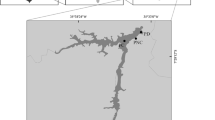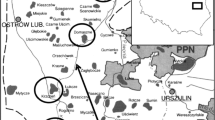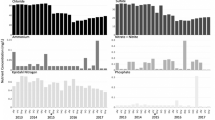Abstract
The survival and subsequent growth potential of Anabaena spp. and other filamentous cyanobacteria and the cells of Aulacoseira spp. (diatom) and Ceratium hirundinella (dinoflagellate) following passage through the Multi Level Inlet Tower (MLIT) and offtake works at Chaffey Reservoir in New South Wales, Australia was investigated in late summer. The study aimed to test whether the phytoplankton cells were destroyed or otherwise rendered less viable during passage through the outlet works. The reservoir was strongly thermally stratified with a shallow surface mixed layer, which contributed to considerable temporal variability in the numbers of phytoplankton cells present immediately opposite the intake portal of the outlet works. To compensate, considerable replicate sampling was undertaken both upstream and downstream of the MLIT. Results indicate limited destruction of cyanobacteria, with fewer cells present immediately downstream compared to upstream. Greater destruction of cells was indicated at lower mean daily discharge rates compared to higher discharge rates. Filament lengths of both cyanobacteria and Aulacoseira were also reduced during passage. There was no apparent reduction in Ceratium cell number. Laboratory incubation studies on surviving cells collected downstream indicated no impairment on the viability of any taxa. Calculations of rates-of-strain likely to be experienced by the phytoplankton as they transited through the offtake revealed very high stress being applied to the filaments and cells at the valve, and within the spillway sections of the works. These were several orders of magnitude greater than published values shown to disrupt cells and filaments, and to impair viability for subsequent growth in laboratory studies. However, exposure times to the high rates-of-strain at Chaffey Reservoir were brief, which may reduce the impacts of the high turbulence. The conclusions were that unless cyanobacterial cell destruction during passage through an outlet works can be shown to be more effective at larger reservoirs, the withdrawal of warm, cyanobacterial infested waters from close to the surface is unlikely to provide an acceptable management action for the prevention of cold water pollution downstream.









Similar content being viewed by others
References
Beutler, M., K. H. Wilstshire, B. Meyer, C. Moldaenke, C. Lüring, M. Mayerhöfer, U.-P. Hansen & H. Dau, 2002. A fluorometric method for the differentiation of algal populations in vivo and in situ. Photosynthetic Research 72: 39–53.
Beutler, M., K. H. Wilstshire, M. Arp, J. Kruse, C. Reineke, C. Moldaenke & U.-P. Hansen, 2003. A reduced model of the fluorescence from the cyanobacterial photosynthetic apparatus designed for the in situ detection of cyanobacteria. Biochimica et Biophysica Acta 1604: 33–46.
Bormans, M., B. S. Sherman & I. T. Webster, 1999. Is buoyancy regulation in cyanobacteria an adaptation to exploit separation of light and nutrients? Marine and Freshwater Research 50: 897–906.
Brookes, J. D. & G. G. Ganf, 2001. Variations in the buoyancy response of Microcystis aeruginosa to nitrogen, phosphorus and light. Journal of Plankton Research 23: 1399–1411.
Brookes, J. D., G. G. Ganf, D. Green & J. Whittington, 1999. The influence of light and nutrients on buoyancy, filament aggregation and flotation of Anabaena circinalis. Journal of Plankton Research 21: 327–341.
Conover, W. J., 1980. Practical Nonparametric Statistics, 2nd Ed. Wiley, New York.
Duarte, C. M., 1990. Time lags in algal growth: generality, causes and consequences. Journal of Plankton Research 12: 873–883.
Falconer, I. R., 2001. Toxic cyanobacterial bloom problems in Australian waters: risks and impacts on human health. Phycologia 40: 228–233.
Genty, B., J. M. Briantais & N. R. Baker, 1989. The relationship between the quantum yield of photosynthetic electron transport and quenching of chlorophyll fluorescence. Biochimica et Biophysica Acta 990: 87–92.
Gill, A. E., 1982. Atmosphere—Ocean Dynamics. Academic Press, New York.
Harris, J. H., 1997. Environmental rehabilitation and carp control. In Roberts, J. & R. Tilzey (eds), Controlling Carp: Exploring the Options for Australia. CSIRO Land and Water, Griffith, Australia: 21–36.
Hötzel, G. & R. Croome, 1999. A Phytoplankton Methods Manual for Australian Freshwaters. Land and Water Resources Research and Development Corporation, Canberra, Australia.
Kobayashi, T., 1992. Plankton of Lyell Reservoir, New South Wales. Proceedings of the Linnean Society of New South Wales 113: 245–261.
Koehn, J., T. Doeg, D. Harrington & G. Milledge, 1997. Dartmouth Dam: Effects on the downstream aquatic fauna. In Banens, R. J. & R. Lehane (eds), 1995 Riverine Environment Research Forum. Murray Darling Basin Commission, Canberra, Australia: 49–56.
Kolbowski, J. & U. Schreiber, 1995. Computer-controlled phytoplankton analyzer based on a 4-wavelengths PAM chlorophyll fluorometer. In Mathis, P. (ed.), Photosynthesis: From Light to Biosphere, Vol. V. Kluwer Academic Publishers, Dordrecht, Netherlands: 825–828.
Kuiper-Goodman, T., I. Falconer & J. Fitzgerald, 1999. Human health aspects. In Chorus, I. & J. Bartram (eds), Toxic Cyanobacteria in Water. A Guide to Their Public Health Consequences, Monitoring and Management. E and FN Spon, London, UK: 113–153.
Lund, J. W. G., 1959. A simple counting chamber for nanoplankton. Limnology and Oceanography 4: 57–65.
Maxwell, K. & G. N. Johnson, 2000. Chlorophyll fluorescence—a practical guide. Journal of Experimental Botany 51: 659–668.
Miles, D., 1991. The role of chlorophyll fluorescence as a bioassay for assessment of toxicity in plants. In Wang, W., J. W. Gorsuch & W. R. Lower (eds), Plants for Toxicity Assessment. American Society for Testing and Materials. Philadelphia, USA: 297–307.
Moisander, P. H., J. L. Hench, K. Kononen & H. W. Paerl, 2002. Small-scale shear effects on heterocystous cyanobacteria. Limnology and Oceanography 47: 108–119.
O’Brien, K. R., D. L. Meyer, A. M. Waite, G. N. Ivey & D. P. Hamilton, 2004. Disaggregation of Microcystis aeruginosa colonies under turbulent mixing: laboratory experiments in a grid-stirred tank. Hydrobiologia 519: 143–152.
Oliver, R. L., 1994. Floating and sinking in gas-vacuolate cyanobacteria. Journal of Phycology 30: 161–173.
Petts, G. E., 1986. Water quality characteristics of regulated rivers. Processes in Physical Geography 10: 492–516.
Preece, R., 2004. Cold water pollution below dams in New South Wales. Department of Infrastructure, Planning and Natural Resources, Water Management Division, Sydney, Australia.
Preece, M. R. & H. A. Jones, 2002. The effect of Keepit Dam on the temperature regime of the Namoi River, Australia. River Research and Applications 18: 397–414.
Ralph, P. J., A. W. D Larkum & M. Kühl, 2005. Temporal patterns in effective quantum yield of individual zooxanthellae expelled during bleaching. Journal of Experimental Marine Biology and Ecology 316: 17–28.
Regel, R. H., J. D. Brookes, G. G. Ganf & R. W. Griffiths, 2004. The influence of experimentally generated turbulence on the Mash01 unicellular Microcystis aeruginosa strain. Hydrobiologia 517: 107–120.
Reynolds, C. S., 1984. The Ecology of Freshwater Phytoplankton. Cambridge University Press, Cambridge, UK.
Reynolds, C. S., G. H. M. Jaworski, H. A. Cmiech & G. F. Leedale, 1981. On the annual cycle of the blue-green alga Microcystis aeruginosa Kutz. Emend. Elenkin. Philosophical Transactions of the Royal Society B: Biological Sciences 293: 419–477.
Rubins, H. & J. Atkinson, 2001. Environmental Fluid Mechanics. Marcel Dekker, Inc, New York.
Schreiber, U., 1998. Chlorophyll fluorescence: new instruments for special applications. In Garab G. (ed.), Photosynthesis: Mechanisms and Effects, Vol. 5. Kluwer Academic Publishers, Dordrecht, Netherlands: 4253–4258.
Schreiber, U., C. Neubauer & U. Schliwa, 1993. PAM fluorometer based on medium-frequency pulsed Xe-flash measuring light: a highly sensitive new tool in basic and applied photosynthesis research. Photosynthesis Research 36: 65–72.
Sherman, B., P. Ford, P. Hatton, J. Whittington, D. Green, D. Baldwin, R. Oliver, R. Shiel, J. van Berkel, R. Beckett, L. Grey & B. Maher, 2001. The Chaffey Dam Story. Final Report for CRCFE Projects B.202 and B.203. Cooperative Research Centre for Freshwater Ecology, University of Canberra, ACT, Australia.
Tennekes, H. & J. L. Lumley, 1972. A First Course in Turbulence. The MIT Press, Cambridge, UK.
Thomas, W. H. & C. H. Gibson, 1990. Effects of small-scale turbulence on microalgae. Journal of Applied Phycology 2: 71–77.
Visser, P. M., J. Passarge & L. R. Mur, 1997. Modelling vertical migration of the cyanobacterium Microcystis. Hydrobiologia 349: 99–109.
Walker, K. F., 1980. The downstream influence of Lake Hume on the River Murray. In Williams W. D. (ed.), An Ecological Basis for Water Resource Management. Australian National University Press, Canberra, Australia: 182–191.
Webster, I. T., 1990. Effect of wind on the distribution of phytoplankton in lakes. Limnology and Oceanography 35: 989–1001.
Webster, I. T. & P. A. Hutchinson, 1994. Effect of wind on the distribution of phytoplankton cells in lakes revisited. Limnology and Oceanography 39: 365–373.
Acknowledgements
We thank the State Water Corporation staff at Chaffey Reservoir (Greg Walker, Nick Burr and Paul Guihot) for their assistance during the conduct of the experiment. Richard Gardiner (DECC) provided field assistance and Hugh Jones (DNR) statistical assistance. Algal counts were undertaken by Derek Cannon (Phyto-ID). We thank Gillian Dunkerley, Gavin Doyle and Tim Pritchard (DECC) and Russell Preece (DNR) for useful discussion. We thank Rod Oliver (MDFRC) and Simon Mitrovic (DWE) for providing critical review on an early draft of the manuscript. The views and conclusions of the article are those of the authors and do not necessarily represent the official policies, either expressed or implied, by the respective organisation.
Author information
Authors and Affiliations
Corresponding author
Additional information
Handling editor: D. Ryder
Rights and permissions
About this article
Cite this article
Ingleton, T., Kobayashi, T., Sanderson, B. et al. Investigations of the temporal variation of cyanobacterial and other phytoplanktonic cells at the offtake of a large reservoir, and their survival following passage through it. Hydrobiologia 603, 221–240 (2008). https://doi.org/10.1007/s10750-007-9274-z
Received:
Revised:
Accepted:
Published:
Issue Date:
DOI: https://doi.org/10.1007/s10750-007-9274-z




